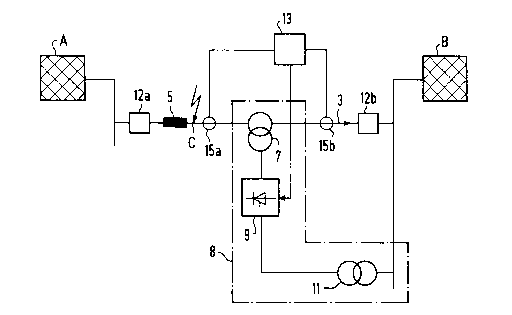Some of the information on this Web page has been provided by external sources. The Government of Canada is not responsible for the accuracy, reliability or currency of the information supplied by external sources. Users wishing to rely upon this information should consult directly with the source of the information. Content provided by external sources is not subject to official languages, privacy and accessibility requirements.
Any discrepancies in the text and image of the Claims and Abstract are due to differing posting times. Text of the Claims and Abstract are posted:
| (12) Patent Application: | (11) CA 2168025 |
|---|---|
| (54) English Title: | METHOD FOR SHORT-CIRCUIT CURRENT LIMITING ON AN ELECTRICAL POWER TRANSMISSION LINE, AND AN ARRANGEMENT FOR SHORT-CIRCUIT LIMITING |
| (54) French Title: | METHODE POUR LIMITER LE COURANT DE COURT-CIRCUIT SUR UNE LIGNE DE TRANSMISSION D'ELECTRICITE, ET ARRANGEMENT CORRESPONDANT |
| Status: | Deemed Abandoned and Beyond the Period of Reinstatement - Pending Response to Notice of Disregarded Communication |
| (51) International Patent Classification (IPC): |
|
|---|---|
| (72) Inventors : |
|
| (73) Owners : |
|
| (71) Applicants : |
|
| (74) Agent: | SMART & BIGGAR LP |
| (74) Associate agent: | |
| (45) Issued: | |
| (86) PCT Filing Date: | 1994-07-13 |
| (87) Open to Public Inspection: | 1995-02-02 |
| Examination requested: | 1996-01-24 |
| Availability of licence: | N/A |
| Dedicated to the Public: | N/A |
| (25) Language of filing: | English |
| Patent Cooperation Treaty (PCT): | Yes |
|---|---|
| (86) PCT Filing Number: | PCT/DE1994/000806 |
| (87) International Publication Number: | WO 1995003645 |
| (85) National Entry: | 1996-01-24 |
| (30) Application Priority Data: | ||||||
|---|---|---|---|---|---|---|
|
In order to obtain an improved operating behavior
relative to the prior art in the event of short circuits
on a high-voltage line (3) having a phase shifter (8), it
is provided for the phase shifter (8) to be used as a
current limiter in the event of a fault. A fault signal,
which results in an opposing voltage on the additional
transformer (7) of the phase shifter (8) being increased,
is produced for this purpose, as a function of the fault
current.
Afin de maintenir, en cas de courts-circuits sur une ligne haute tension (3) pourvue d'un déphaseur, une meilleure tenue en service par rapport à l'état actuel de la technique, il est prévu d'utiliser le déphaseur (8) comme limiteur de courant en cas de défaut. Un signal d'erreur produit en fonction du courant de défaut provoque une augmentation d'une contre-tension sur le transformateur additionnel (7) du déphaseur (8).
Note: Claims are shown in the official language in which they were submitted.
Note: Descriptions are shown in the official language in which they were submitted.

2024-08-01:As part of the Next Generation Patents (NGP) transition, the Canadian Patents Database (CPD) now contains a more detailed Event History, which replicates the Event Log of our new back-office solution.
Please note that "Inactive:" events refers to events no longer in use in our new back-office solution.
For a clearer understanding of the status of the application/patent presented on this page, the site Disclaimer , as well as the definitions for Patent , Event History , Maintenance Fee and Payment History should be consulted.
| Description | Date |
|---|---|
| Inactive: IPC from MCD | 2006-03-12 |
| Application Not Reinstated by Deadline | 2000-07-13 |
| Time Limit for Reversal Expired | 2000-07-13 |
| Deemed Abandoned - Conditions for Grant Determined Not Compliant | 1999-11-18 |
| Deemed Abandoned - Failure to Respond to Maintenance Fee Notice | 1999-07-13 |
| Notice of Allowance is Issued | 1999-05-18 |
| Notice of Allowance is Issued | 1999-05-18 |
| Letter Sent | 1999-05-18 |
| Inactive: Status info is complete as of Log entry date | 1999-05-12 |
| Inactive: Application prosecuted on TS as of Log entry date | 1999-05-12 |
| Inactive: Approved for allowance (AFA) | 1999-05-04 |
| All Requirements for Examination Determined Compliant | 1996-01-24 |
| Request for Examination Requirements Determined Compliant | 1996-01-24 |
| Application Published (Open to Public Inspection) | 1995-02-02 |
| Abandonment Date | Reason | Reinstatement Date |
|---|---|---|
| 1999-11-18 | ||
| 1999-07-13 |
The last payment was received on 1998-06-17
Note : If the full payment has not been received on or before the date indicated, a further fee may be required which may be one of the following
Please refer to the CIPO Patent Fees web page to see all current fee amounts.
| Fee Type | Anniversary Year | Due Date | Paid Date |
|---|---|---|---|
| MF (application, 3rd anniv.) - standard | 03 | 1997-07-14 | 1997-06-17 |
| MF (application, 4th anniv.) - standard | 04 | 1998-07-13 | 1998-06-17 |
Note: Records showing the ownership history in alphabetical order.
| Current Owners on Record |
|---|
| SIEMENS AKTIENGESELLSCHAFT |
| Past Owners on Record |
|---|
| WALTER MULLER |